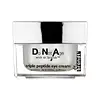What's inside
What's inside
 Key Ingredients
Key Ingredients

 Benefits
Benefits

 Concerns
Concerns

 Ingredients Side-by-side
Ingredients Side-by-side

Water
Skin ConditioningButyrospermum Parkii Butter
Skin ConditioningCetyl Palmitate
EmollientCyclopentasiloxane
EmollientMethylsilanol Hydroxyproline Aspartate
Skin ConditioningSiloxanetriol Alginate
Skin ConditioningC12-16 Alcohols
EmollientGlycerin
HumectantCetyl Alcohol
EmollientCetyl Lactate
EmollientOctyldodecyl Stearate
EmollientGlyceryl Stearate Citrate
EmollientBis-Hydroxyethoxypropyl Dimethicone
EmollientButylene Glycol
HumectantDimethicone
EmollientPalmitic Acid
EmollientSimmondsia Chinensis Seed Oil
EmollientCitrus Limon Fruit Extract
MaskingLavandula Angustifolia Oil
MaskingRetinyl Palmitate
Skin ConditioningCamellia Sinensis Leaf Extract
AntimicrobialVitis Vinifera Fruit Extract
Skin ConditioningCeramide NP
Skin ConditioningTocopheryl Acetate
AntioxidantCamellia Oleifera Leaf Extract
AstringentSodium Acrylates Copolymer
Hydrogenated Polyisobutene
EmollientPhospholipids
Skin ConditioningPolyglyceryl-10 Stearate
Skin ConditioningHelianthus Annuus Seed Oil
EmollientPhenoxyethanol
PreservativeEthylhexylglycerin
Skin ConditioningCaffeine
Skin ConditioningLecithin
EmollientAcetyl Hexapeptide-8
HumectantGlyceryl Polymethacrylate
Propylene Glycol
HumectantPalmitoyl Tripeptide-1
Skin ConditioningAlcohol Denat.
AntimicrobialPolyglyceryl-3 Stearate
EmulsifyingSodium Hydroxide
BufferingDisodium EDTA
Xanthan Gum
EmulsifyingBHT
AntioxidantSodium PCA
HumectantAcetyl Citrull Amido Arginine
Skin ProtectingBetaine
HumectantPotassium Sorbate
PreservativeWater, Butyrospermum Parkii Butter, Cetyl Palmitate, Cyclopentasiloxane, Methylsilanol Hydroxyproline Aspartate, Siloxanetriol Alginate, C12-16 Alcohols, Glycerin, Cetyl Alcohol, Cetyl Lactate, Octyldodecyl Stearate, Glyceryl Stearate Citrate, Bis-Hydroxyethoxypropyl Dimethicone, Butylene Glycol, Dimethicone, Palmitic Acid, Simmondsia Chinensis Seed Oil, Citrus Limon Fruit Extract, Lavandula Angustifolia Oil, Retinyl Palmitate, Camellia Sinensis Leaf Extract, Vitis Vinifera Fruit Extract, Ceramide NP, Tocopheryl Acetate, Camellia Oleifera Leaf Extract, Sodium Acrylates Copolymer, Hydrogenated Polyisobutene, Phospholipids, Polyglyceryl-10 Stearate, Helianthus Annuus Seed Oil, Phenoxyethanol, Ethylhexylglycerin, Caffeine, Lecithin, Acetyl Hexapeptide-8, Glyceryl Polymethacrylate, Propylene Glycol, Palmitoyl Tripeptide-1, Alcohol Denat., Polyglyceryl-3 Stearate, Sodium Hydroxide, Disodium EDTA, Xanthan Gum, BHT, Sodium PCA, Acetyl Citrull Amido Arginine, Betaine, Potassium Sorbate
 Reviews
Reviews

Ingredients Explained
These ingredients are found in both products.
Ingredients higher up in an ingredient list are typically present in a larger amount.
Butylene Glycol (or BG) is used within cosmetic products for a few different reasons:
Overall, Butylene Glycol is a safe and well-rounded ingredient that works well with other ingredients.
Though this ingredient works well with most skin types, some people with sensitive skin may experience a reaction such as allergic rashes, closed comedones, or itchiness.
Learn more about Butylene GlycolGlycerin is already naturally found in your skin. It helps moisturize and protect your skin.
A study from 2016 found glycerin to be more effective as a humectant than AHAs and hyaluronic acid.
As a humectant, it helps the skin stay hydrated by pulling moisture to your skin. The low molecular weight of glycerin allows it to pull moisture into the deeper layers of your skin.
Hydrated skin improves your skin barrier; Your skin barrier helps protect against irritants and bacteria.
Glycerin has also been found to have antimicrobial and antiviral properties. Due to these properties, glycerin is often used in wound and burn treatments.
In cosmetics, glycerin is usually derived from plants such as soybean or palm. However, it can also be sourced from animals, such as tallow or animal fat.
This ingredient is organic, colorless, odorless, and non-toxic.
Glycerin is the name for this ingredient in American English. British English uses Glycerol/Glycerine.
Learn more about GlycerinPhenoxyethanol is a preservative that has germicide, antimicrobial, and aromatic properties. Studies show that phenoxyethanol can prevent microbial growth. By itself, it has a scent that is similar to that of a rose.
It's often used in formulations along with Caprylyl Glycol to preserve the shelf life of products.
Water. It's the most common cosmetic ingredient of all. You'll usually see it at the top of ingredient lists, meaning that it makes up the largest part of the product.
So why is it so popular? Water most often acts as a solvent - this means that it helps dissolve other ingredients into the formulation.
You'll also recognize water as that liquid we all need to stay alive. If you see this, drink a glass of water. Stay hydrated!
Learn more about Water